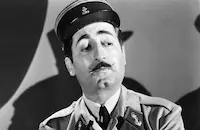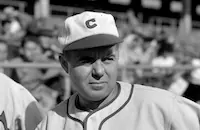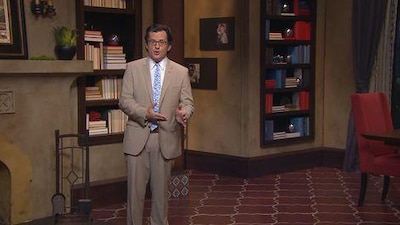The Beast with Five Fingers

Brief Synopsis
Cast & Crew
Robert Florey
Robert Alda
Andrea King
Peter Lorre
Victor Francen
J. Carrol Naish
Film Details
Technical Specs

Synopsis
In the small Italian village of San Stefano at the turn of the nineteenth century, small-time confidence man and former musician Conrad Ryler, who now calls himself Bruce Conrad, pays a call on the occupants of the Villa Francesca. They include the villa's owner, Francis Ingram, a partially paralyzed pianist, his beautiful nurse, Julie Holden, and his secretary, Hilary Cummins. When Bruce compliments Ingram on his powerful piano playing, Ingram, who only has the use of one hand, credits Julie's care and inspiration. Unknown to Ingram, however, Julie plans to leave her position. This news greatly upsets Hilary, as her presence frees him to continue his studies of astrology. That night, at a dinner attended by Hilary, Julie, Bruce and Ingram's lawyer, Duprex, Ingram asks his guests to testify to his sanity and then has Bruce and Hilary witness his will. Later, Hilary eavesdrops as Julie invites Bruce to leave Italy and start a new life with her. When Hilary reveals her plans to Ingram, Ingram calls him a liar and chokes him with his good hand. Only Julie's intervention saves Hilary's life. Later, Ingram wakes in the middle of the night and, failing to rouse Julie, wheels himself out of his room and accidentally falls down the stairs to his death. The funeral is attended by Ingram's only relatives, Raymond Arlington and his son Donald. To their dismay, Ingram's will leaves everything to Julie, who announces that she will accept the legacy and remain in Italy. Duprex then offers to help the Arlingtons contest the will for a third of the estate. That night, the villa's residents see a light in the mausoleum and later Ingram's distinctive arrangement of Bach is heard on the piano, although no one appears to be playing it. After Duprex' body is found nearby, the police commissioner discovers that Ingram's good hand has been cut from his body. The commissioner also reveals that the window of the mausoleum has been broken from the inside, and handprints have been left on the ground beneath. Meanwhile, Donald remembers a hidden safe in Ingram's study and tells Hilary that he is sure an earlier will is inside. After dark, Donald sneaks into the library, watched by the commissioner, and while the piano mysteriously plays, a hand reaches out and chokes Donald. The commissioner saves him from the attack, but later, as Hilary sits in the library, he sees a disembodied hand crawl toward him. Fearfully, he captures it and nails it to a board so that it cannot escape. In the middle of the night, Donald remembers that the combination to the safe is based on the number of bones in the hand. He, his father, and the commissioner open the safe and find the hand. In the confusion that follows, Hilary and Julie are left alone together. Julie asks Hilary to confess to the murder of Duprex and the attack on Donald, but learning that she has told no one of her suspicions, Hilary attacks her. Julie is saved when Hilary hears the piano playing. Now completely mad, he tries to burn the hand, but it chokes him to death. Later, the commissioner finds the wire that Hilary used to activate a recording of Ingram playing the piano and reveals that the appearances of the hand were all in Hilary's mind. The mystery solved, Julie turns the villa over to the Arlingtons and leaves with Bruce.

Director

Robert Florey
Cast

Robert Alda

Andrea King

Peter Lorre

Victor Francen

J. Carrol Naish

Charles Dingle

John Alvin
David Hoffman
Barbara Brown

Patricia White
William Edmunds
Belle Mitchell

Ray Walker
Pedro De Cordoba
Antonio Filauri
Joseph Marievsky
Gino Corrado
Franco Corsaro
Count Stefenelli
Symona Boniface
Edna Morris
Elinor Van Der Veer
Katherine Wallace
Crew
Gerald W. Alexander
Wesley Anderson
Della Barnes
Lester H. Blackburn
Russell Collings
Jack Daniels
David Dans
Paul Detlefsen
E. F. Dexter
Frank Evans
Stanley Fleischer
Leo F. Forbstein
Charles David Forrest
Hugo Friedhofer
Oliver Garretson
Harold Goldman
Lou Hafley
Chuck Hansen
Gene Hibbs
William Jacobs
Mac Julian
H. F. Koenekamp
Mario Larrinaga
Art Lueker
Frank Magee
William Mcgann
Sid Mintz
Joe O'connell
John Prettyman
Meta Rebner
Jonah Ruddy
Dario Sabatello
Curt Siodmak
Max Steiner
Walter Tilford
Travilla
Bertram Tuttle
Jack L. Warner
Robert G. Wayne
Perc Westmore
Mina Willowbird

Videos
Movie Clip



Trailer
Hosted Intro
Film Details
Technical Specs

Articles
The Beast with Five Fingers on DVD
That all comes later. The film opens with Robert Alda as an American in Italy fleecing tourists with ersatz jewelry and a line of malarkey sold with a devilish grin. That's just a sideline for Conrad Ryler, a former musician who is now part of the retinue that serves Francis Ingram (Victor Francen), a piano maestro paralyzed by a stroke but for one arm, with which he uses to pound out Brahms on the grand piano that dominates the front room. Ingram's nurse Julie (Andrea King) and his secretary Hilary (Peter Lorre), an obsessive who is usually squirrelled away in the library studying ancient astrology and magic, fill out Ingram's staff, and it's a rather strained sense of community.
Ingram is hopelessly in love with Julie but the feeling is not mutual. Hilary is a recluse, fidgety and nervous in social situations and drawn out of the library only at the command of Ingram, who is a rather imperious boss. Alda comes off like a slightly-less seedy Zachary Scott as Conrad, with his insincere smile and oily manner, but the con man we see in the first scene gives way to a more troubled character all but trapped in the employ of Ingram and his own love for Julie, which he has to suppress around Ingram. J. Carroll Naish is the local police commissario, a regular visitor to the castle and a not-entirely-successful conscience for Conrad. Naish was actually Irish-American but his Mediterranean features got him cast as Italians, Greeks, even French-Canadians along with the usual American character parts, and he puts on his meatball accent to play the role as a jovial stereotype, part superstitious rube and part savvy cop.
When Ingram dies, the funeral and the reading of the will brings out the surviving relatives, the usual collection of greedy, conniving souls, and they contest Ingram's newly-amended will when it's revealed that he left the entire estate to Julie. Needless to say, their bodies start stacking up. Strangled, in fact, ostensibly by the disembodied hand of the dead piano virtuoso. What else would wake the castle's inhabitants in the middle of the night with one-handed concerts on the grand piano?
We actually get to see the hand as it skitters through the film in the second half. Created by Florey and the Warner effects team (led by an uncredited Russell Collings) through a mix of double exposures, travelling mattes, simple sleight of hand and carefully-calibrated camera angles, wires, and an articulated mechanical prop, it is magnificent creation. The latter is the least convincing but for the most part this hand, seen only by Hilary (is it real or just a hallucination on his part?), is a character in its own right as is spiderwalks across a desk, crawls up the clothes of its victims and the curtains of the castle walls, and skitters behind the bookshelves of the library, knocking volumes to the floor as it tries to escape Hilary. There's a marvelous madness to the film its best. Lorre teeters on the edge of insanity as he chases down the hand and the images of Lorre fumbling to hold onto the wriggling hand or intently hammering it to a chunk of wood are so surreal and disturbing they defy description. The script itself, penned by horror veteran Curt Siodmak, is less convincing, and the end of the film cheats the ambiguity and atmosphere that Florey so effectively orchestrates. It's a matter of studio interference imposing a literal explanation and a cheesy comic coda that makes light of everything. Give credit to Naish for carrying it off the jokey ethnic comedy with good humor and not a trace of condescension to the audience, who he addresses directly in the final scenes.
Warner released The Beast with Five Fingers on videotape decades ago but this is first release on disc. Word through the grapevine is that reason for the delay was the poor condition of the original film elements, which sounds right given the company's track record. The print quality is just a notch below the usual Warner standard for its archival films, with some wear on the print and evident digital clean-up in some sections, but Warner has maintained pretty high standards for the Archive releases and they have done a fine job at rescuing this film and presenting it in a perfectly watchable copy. There is minimal visible damage and a clean soundtrack. The disc features the original trailer.
by Sean Axmaker

The Beast with Five Fingers on DVD
The Beast with Five Fingers - The Beast With Five Fingers
Equally memorable is Robert Florey's innovative direction which is partly inspired by German Expressionist films like The Cabinet of Dr. Caligari (1920) and Florey's own interest in the avant-garde. Bizarre camera angles and point-of-view shots (the hand crawling behind a row of books in the library), dramatic lighting and foreboding sets help create the mood of a paranoid hallucination, all of which is a reflection of Cummins' distorted mental state. Even the music score by Max Steiner enhances the general sense of escalating madness and manages to make a simple piano sonata sound menacing. But how could it be otherwise when you know the musician on the piano is a severed hand?
With The Beast With Five Fingers Florey finished out his contract with Warner Bros. and it was one of his worst working experiences with the studio; initially he didn't even want to direct it. Probably the most difficult aspect of it was the special effects. From the very beginning, the animated hand was a challenge. According to biographer Brian Taves in Robert Florey: The French Expressionist (Scarecrow Press), "The special effects department received the following instructions:
> Glove hand with stump, ready for photographic test Tuesday, December 11, 1945.
> Mechanical hand to claw at face and throat ready for photographic test Thursday, December 13th, 1945.
There was even some disagreement over the aesthetic properties the hand should possess. Mr. Trilling saw the test and objected to the length of the wrist on the present hand, and there was some mention of using a longer, scrawnier hand. If we use the present hand, it can be cut down and made irregular at the wrist...All of this brought out Florey's sometimes macabre sense of humor, and so he decided to have as much fun with it as possible." In one scene, Florey hid under a table and used his own hand as the "Beast," having it crawl out of a box on top. For the scene where the hand plays the piano, camera technicians covered musician Erwin Nyrigegyhazi in black cloth except for one hand which crawled across the keyboard (the eerie effect was completed in post-production).
Not surprisingly, The Beast With Five Fingers has the look of a lavish A-picture thanks to Florey's artistry but the director publicly disowned the final studio cut stating that most of his creative concepts and script suggestions were ignored. For instance, the long-winded epilogue in which a police inspector (J. Carrol Naish) is brought in to decipher the strange events for clueless moviegoers is one of the more obvious studio-approved changes. Only the sequence with Lorre being pursued and tormented by the hand in the library remains faithful to Florey's original intentions. And Lorre is truly a sight to behold in this film, wavering between quiet dementia and total hysteria; his performance carries the film just as it did in The Face Behind the Mask (1941), his previous collaboration with Florey.
One fascinating bit of trivia about The Beast With Five Fingers: Spanish director Luis Bunuel, the master of surrealist cinema, was under contract to Warner Bros. in 1945. According to John Baxter in his biography, Bunuel, "Some sources claim that Bunuel planned the entire severed hand sequence, but that producer William Jacobs vetoed the result as too florid. Bunuel himself insisted that his ideas were the entire basis of the script." But no records exist of this in any Warner Bros. file on the movie and Florey has never referred to Bunuel in any mention of The Beast With Five Fingers. However, in Conversations with Luis Bunuel conducted by Jose de la Colina and Tomas Perez Turrent, the director revealed "I wrote it [The Beast With Five Fingers] in order to charge them for an entire sequence, even though it was not filmed (I needed money). I imagined a cut-off hand that had a life of its own. Later, they filmed it and didn't pay me anything. I wanted to sue the company but I was already here in Mexico and I decided against it. I received my salary at the company, but that was a job I did on the side. As you two remember, there was already a scene with an amputated hand in Un Chien Andalou [1929]. I also used a severed hand that moved in The Exterminating Angel [1967]." Mystery solved, case closed.
Producer: William Jacobs
Director: Robert Florey
Screenplay: William Fryer Harvey (story), Curt Siodmak
Cinematography: Wesley Anderson
Film Editing: Frank Magee
Art Direction: Stanley Fleischer
Music: Max Steiner
Cast: Robert Alda (Bruce Conrad), Andrea King (Julie Holden), Peter Lorre (Hilary Cummins), Victor Francen (Francis Ingram), J. Carrol Naish (Ovidio Castanio), Charles Dingle (Raymond Arlington).
BW-89m. Closed captioning.
by Jeff Stafford
The Beast with Five Fingers - The Beast With Five Fingers
Quotes
Trivia
Luis Bu?uel wrote in his autobiography ("My Last Sigh"), he was employed by Warner Brothers and submitted a story idea for a horror movie about a disembodied hand.
This was 'Peter Lorre' 's last film for Warner Brothers.
Notes
The film begins with the following written foreword: "This is the story of what happened-or seemed to happen-in the small Italian village of San Stefano nearly 50 years ago." A November 15, 1945 Hollywood Reporter news item reports that Paul Henreid was to star but turned down the role of "Conrad Ryler" and was placed on suspension. Robert Alda replaced him.
















